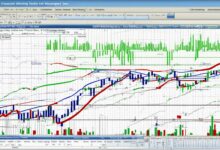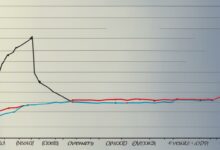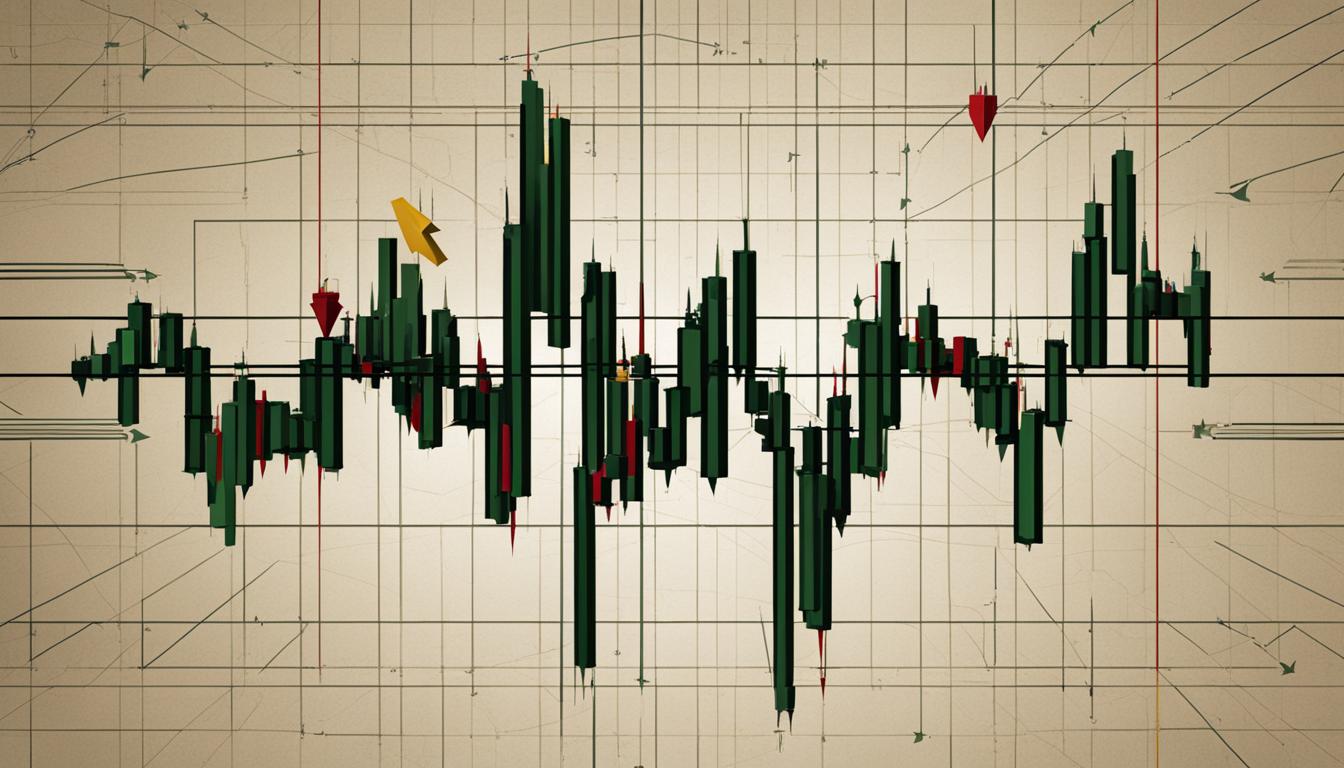Swing Trading Vs Trend Trading: Understanding The Difference

Swing trading and trend trading are two popular strategies in the financial markets. While swing trading focuses on short-term price movements and trading within ranges, trend trading involves trading in line with the overall price trends for longer durations. Understanding the key differences between these strategies can help investors optimize their trading approach and increase their chances of success.
Key Takeaways:
- Swing trading involves profiting from shorter-term price swings within a defined range.
- Trend trading focuses on trading in line with the overall price trends for longer durations.
- Differences include trading approach, holding periods, risk management, and profitability.
- Consider your trading style, time commitment, and risk tolerance when choosing between the two.
- Optimizing your trading strategy requires mastering technical analysis, risk management, position sizing, market analysis, and continuous education.
What is Swing Trading?
Swing trading is a short-term trading strategy where traders aim to profit from the price swings or fluctuations within a defined range. Swing traders typically buy at support levels and sell at resistance levels, taking advantage of the predictable price movements. This strategy is characterized by shorter time frames, ranging from a few days to a few weeks.
The benefits of swing trading include the ability to capture shorter-term profits, flexibility in trading time frames, and the potential for high returns. By focusing on short-term price movements, swing traders can take advantage of frequent trading opportunities and capitalize on shorter-term market trends. Additionally, the flexibility in trading time frames allows swing traders to adapt their strategies to different market conditions, optimizing their trading approach.
Overall, swing trading provides traders with the opportunity to generate consistent profits within shorter durations, taking advantage of both upward and downward price movements.

Swing Trading Strategy
Swing traders employ various strategies to identify potential entry and exit points for their trades. Some common techniques include technical analysis, chart patterns, and indicators. Technical analysis involves analyzing historical price data and patterns to predict future price movements. Chart patterns, such as triangles, head and shoulders, and double tops/bottoms, can help identify potential trend reversals or continuation patterns. Indicators like moving averages, stochastic oscillators, and relative strength index (RSI) can provide additional confirmation signals.
Once swing traders identify potential trade setups, they typically set their entry and exit points based on their risk-reward ratio. Stop-loss orders are placed to limit potential losses, while profit targets are set to capture desired profits. Risk management is a crucial component of swing trading as it helps traders minimize losses and protect their capital.
| Swing Trading Time Frames | Swing Trading Benefits |
|---|---|
|
|
“Swing trading allows traders to take advantage of short-term price swings, offering flexibility and the potential for high returns.”
In summary, swing trading is a short-term trading strategy that involves profiting from price swings within a defined range. It offers the benefits of capturing shorter-term profits, flexibility in trading time frames, and the potential for high returns. By using technical analysis and implementing effective risk management strategies, swing traders can optimize their trading approach and increase their chances of success.
What is Trend Trading?
Trend trading is a medium to long-term trading strategy that involves capitalizing on sustained price movements in the direction of the overall trend. Traders who employ this strategy analyze the market using technical analysis tools and indicators to identify the prevailing trend. Once the trend is identified, traders enter positions with the expectation that the trend will continue, allowing them to ride the wave and potentially profit from the extended price movement.
This strategy is characterized by longer time frames, typically ranging from several weeks to several months. Trend traders aim to capture larger profits by staying in positions for an extended period, as they expect the market trend to continue in their favor. This approach requires patience and discipline, as traders need to withstand short-term price fluctuations and focus on the bigger picture.
By focusing on the overall trend, trend traders aim to avoid the noise and volatility associated with short-term price fluctuations. They believe that by following the trend, they can increase their chances of success and maximize their profit potential. This strategy offers the benefit of potentially larger profits, less frequent trading, and the ability to capitalize on sustained price movements.
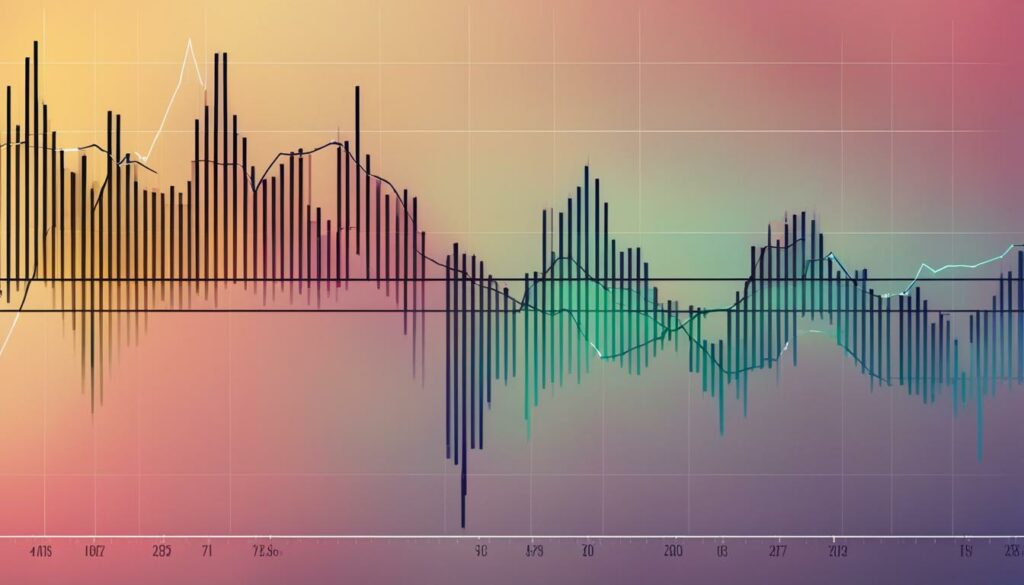
Key Differences Between Swing Trading and Trend Trading
Swing trading and trend trading may both be popular strategies in the financial markets, but they differ in several key aspects, including trading approach, holding periods, risk management, and profitability.
Trading Approach
One of the main distinctions between swing trading and trend trading lies in their trading approaches. Swing traders focus on short-term price movements and take advantage of smaller price swings within a defined range. They aim to capture profits from these short-term fluctuations.
On the other hand, trend traders focus on the overall price trend and aim to ride the trend for longer durations. They identify the trend using technical analysis tools and indicators and enter positions with the expectation that the trend will continue. Their approach is more long-term and aims to capitalize on sustained price movements.
Holding Periods
Another significant difference between swing trading and trend trading is the holding periods. Swing traders hold their positions for shorter time frames, typically ranging from a few days to a few weeks. They aim to take advantage of short-term price movements and exit their positions once their profit targets or stop-loss levels are reached.
In contrast, trend traders hold their positions for longer time frames, ranging from several weeks to several months. They aim to ride the trend for extended periods and capture larger profits. This longer holding period allows them to benefit from sustained price movements in the direction of the trend.
Risk Management
Risk management also differs between swing trading and trend trading. Swing traders often take larger positions and have tighter stop-loss orders to manage risk in their short-term trades. They focus on minimizing losses and maximizing profits within the defined range they are trading in.
Trend traders, on the other hand, may have smaller positions and wider stop-loss orders to allow for the longer duration of their trades. They aim to capture larger profits by riding the trend, but they also accept the potential for larger drawdowns as the price may experience temporary retracements against the trend.
Profitability
Profitability can also vary between swing trading and trend trading. Swing traders aim for smaller but more frequent profits, as they often capture multiple price swings within their defined range.
Trend traders, on the other hand, aim for larger profits but with less frequent trades. They seek to capture the bulk of the price movement in a trend, which can result in larger profits when the trend continues in their favor.
It’s important to note that both swing trading and trend trading can be profitable if executed effectively. The choice between the two strategies depends on individual preferences, risk tolerance, and trading goals.

| Swing Trading | Trend Trading | |
|---|---|---|
| Trading Approach | Focuses on short-term price movements and smaller swings within a range | Focuses on the overall price trend and riding the trend for longer durations |
| Holding Periods | Shorter time frames, ranging from a few days to a few weeks | Longer time frames, ranging from several weeks to several months |
| Risk Management | Larger positions and tighter stop-loss orders | Smaller positions and wider stop-loss orders |
| Profitability | Smaller but more frequent profits | Larger profits but with less frequent trades |
Choosing Between Swing Trading and Trend Trading
When it comes to choosing between swing trading and trend trading, there are several factors to consider. Understanding your trading style, time commitment, and risk tolerance will help you make an informed decision that aligns with your goals.
Firstly, consider your trading style. Are you more comfortable with shorter-term trades and frequent trading, or do you prefer a longer-term perspective and holding positions for extended periods? Swing trading offers the opportunity for more regular profits, while trend trading allows for potentially larger profits but with fewer trades.
Next, think about your time commitment. Swing trading requires active monitoring of price movements within a defined range, which may involve more time spent on analysis and decision-making. On the other hand, trend trading involves capturing sustained price movements, which may require less frequent monitoring and decision-making.
Lastly, assess your risk tolerance. Swing trading involves smaller position sizes and tighter stop-loss orders to manage risk in short-term trades. Trend trading, on the other hand, may involve larger positions and wider stop-loss orders to allow for the longer duration of trades. Consider your comfort level with these risk management approaches.
By taking these factors into account, you can choose between swing trading and trend trading based on your preferences, goals, and risk appetite. Remember, there is no one-size-fits-all approach, and what works for one trader may not work for another. Determine what suits you best and develop a strategy that maximizes your chances of success.
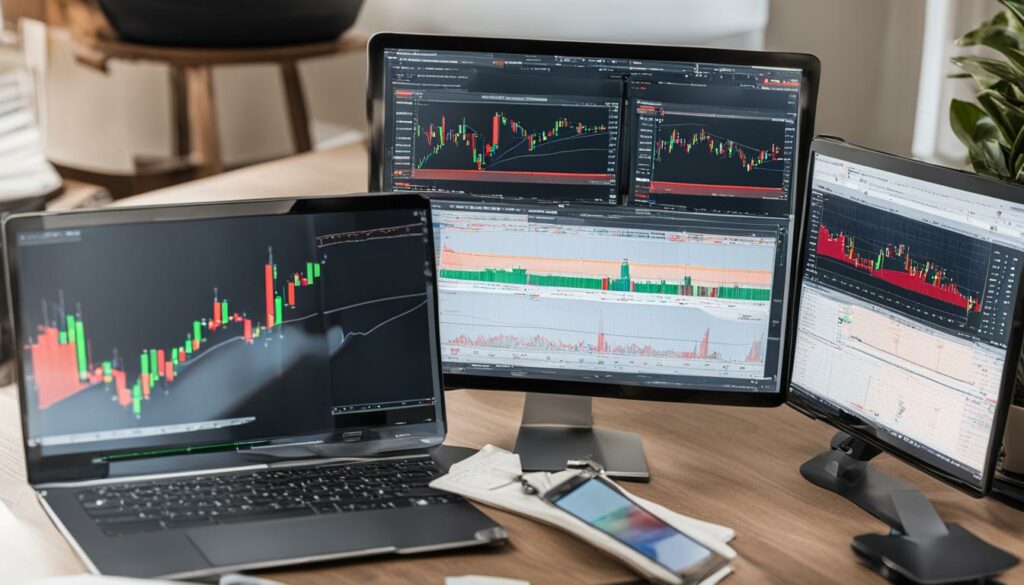
Table: Comparison of Swing Trading and Trend Trading
| Factors | Swing Trading | Trend Trading |
|---|---|---|
| Trading Style | Shorter-term trades, frequent trading | Longer-term perspective, less frequent trading |
| Time Commitment | Active monitoring of price movements | Less frequent monitoring |
| Risk Management | Smaller positions, tighter stop-loss orders | Larger positions, wider stop-loss orders |
| Profit Potential | Smaller but more frequent profits | Larger profits but with less frequent trades |
Benefits of Swing Trading and Trend Trading
Both swing trading and trend trading offer unique advantages that can appeal to different types of traders. Understanding the benefits of each strategy can help you make an informed decision on which approach aligns best with your trading goals and preferences.
Advantages of Swing Trading
Swing trading provides several benefits that make it an attractive strategy for many traders. Firstly, swing trading allows you to capture shorter-term profits by taking advantage of price swings within defined ranges. This can result in more frequent trading opportunities and the potential for higher returns.
Secondly, swing trading offers flexibility in trading time frames. As a swing trader, you have the freedom to choose from a range of time frames, such as a few days to a few weeks, depending on your trading style and preferences. This flexibility allows you to adapt to changing market conditions and take advantage of short-term trends.
Lastly, swing trading can be appealing to traders who prefer an active trading approach. The frequent trades and shorter holding periods in swing trading can provide more excitement and engagement for traders who enjoy being actively involved in the markets.
Advantages of Trend Trading
Trend trading also offers its own set of advantages that may be appealing to certain traders. One key advantage is the potential for larger profits. Trend traders aim to ride the trend for extended periods, allowing them to capture significant price movements and potentially generate substantial returns.
Additionally, trend trading involves less frequent trading compared to swing trading. This can be advantageous for traders who prefer a more relaxed and patient approach. Trend traders typically enter positions when they identify a strong trend, and they hold these positions for longer durations, ranging from several weeks to several months.
Furthermore, trend trading allows traders to take advantage of the overall market trend, which can be easier to predict than short-term price movements. By aligning with the prevailing trend, trend traders can increase their chances of success and reduce the impact of market noise and volatility.
Overall, the choice between swing trading and trend trading depends on your personal preferences, trading style, and risk tolerance. Both strategies offer their own unique benefits, and it’s important to carefully consider these advantages when designing your trading approach. Whichever strategy you choose, remember to continuously evaluate and optimize your trading strategy to increase your chances of success in the dynamic financial markets.

How to Optimize Your Trading Strategy
Optimizing your trading strategy is essential for increasing your chances of success in the financial markets. By considering a few key factors and implementing effective techniques, you can enhance your trading approach and maximize your returns. Here are some important steps to optimize your trading strategy:
1. Conduct Technical Analysis
Technical analysis is a crucial component of optimizing your trading strategy. By analyzing historical price data and utilizing technical indicators, you can identify trends, patterns, and key levels of support and resistance. This information can help you make better-informed trading decisions and improve your timing for entries and exits.
2. Implement Risk Management
Risk management is vital in trading to protect your capital and minimize potential losses. Set clear stop-loss levels for each trade and adhere to them consistently. Additionally, consider implementing strategies such as trailing stops, position sizing techniques, and diversification to manage risk effectively.
3. Evaluate Position Sizing
Proper position sizing is crucial for optimizing your trading strategy. Determine the appropriate percentage of your trading capital to allocate for each trade based on your risk tolerance and the size of your trading account. Avoid overtrading and ensure that your position sizes align with your risk management plan.
4. Conduct Regular Market Analysis
Stay updated on the latest market developments and news that may impact your trades. Regularly analyze market conditions, economic indicators, and industry trends to adjust your strategy accordingly. This will help you stay ahead of potential opportunities and risks in the market.
5. Invest in Trading Education
Continuous learning is essential for optimizing your trading strategy. Invest in trading education resources such as books, courses, webinars, and workshops to enhance your knowledge and skills. Stay up to date with the latest trading techniques, strategies, and market insights to improve your decision-making process.
By implementing these steps, you can optimize your trading strategy and increase your chances of success in the financial markets.
Conclusion
After weighing the key differences and benefits of swing trading and trend trading, it is clear that choosing the right strategy depends on individual preferences, trading style, time commitment, and risk tolerance. Swing trading offers the advantage of capturing shorter-term profits and flexibility in trading time frames, while trend trading allows for potentially larger profits and the ability to ride the trend for extended periods.
When making a decision, consider your personal goals. If you prefer shorter-term trades with more frequent trading and smaller but more regular profits, swing trading may be the ideal choice. On the other hand, if you have a longer-term perspective, are willing to hold positions for extended periods, and are comfortable with fewer but potentially larger profits, trend trading may be more suitable for you.
Remember, it is essential to continuously evaluate and optimize your trading strategy to increase your chances of success. Master technical analysis tools and indicators, develop a robust risk management plan, and regularly analyze market conditions. Additionally, invest in trading education and constantly improve your skills to stay ahead in the ever-changing financial markets. By doing so, you can make an informed decision and choose the approach that aligns best with your goals.
FAQ
What is swing trading?
Swing trading is a short-term trading strategy where traders aim to profit from the price swings or fluctuations within a defined range.
What is trend trading?
Trend trading is a medium to long-term trading strategy where traders aim to profit from the sustained price movements in the direction of the overall trend.
What are the benefits of swing trading?
The benefits of swing trading include the ability to capture shorter-term profits, flexibility in trading time frames, and potential for high returns.
What are the benefits of trend trading?
The benefits of trend trading include the potential for larger profits, less frequent trading, and the ability to ride the trend for extended periods.
What are the key differences between swing trading and trend trading?
One major difference is the trading approach, with swing traders focusing on short-term price movements and trend traders focusing on overall price trends. Another difference is the holding periods, with swing traders holding positions for shorter time frames and trend traders holding positions for longer durations.
How do swing traders manage risk?
Swing traders often take larger positions and have tighter stop-loss orders to manage risk in their short-term trades.
How do trend traders manage risk?
Trend traders may have smaller positions and wider stop-loss orders to allow for the longer duration of their trades.
How do swing trading and trend trading differ in profitability?
Swing traders aim for smaller but more frequent profits, while trend traders aim for larger profits but with less frequent trades.
How should I choose between swing trading and trend trading?
When deciding between swing trading and trend trading, it’s important to consider your trading style, time commitment, and risk tolerance.
What factors should I consider when optimizing my trading strategy?
Factors to consider include mastering technical analysis tools and indicators, developing a robust risk management plan, proper position sizing, regular market analysis, and investing in trading education.
Which trading strategy is better, swing trading or trend trading?
The choice between swing trading and trend trading depends on individual preferences, trading style, time commitment, and risk tolerance.
